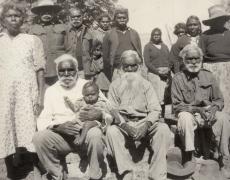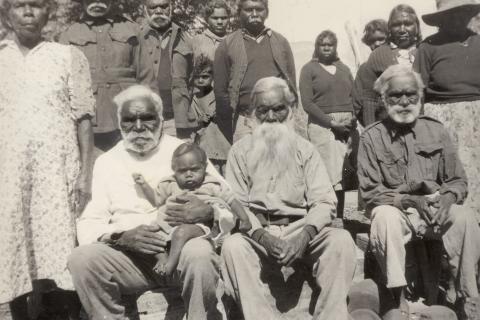Moses Tjalkabota, the charismatic, blind evangelist was a well-known figure in Central Australia. He was a zealous Christian and a master storyteller and attracted large audiences when he preached.
Tjalkabota the child
The recorded date of Moses' birth varies: a newspaper article (Roth 2015) records his birth year as 1872 at Laprapuntja (Ellery Creek) and other sources say 1869 (Albrecht 2005). This was a tumultuous time to be born in Central Australia, it was only 12 years after the first European explorers had ventured into the area and few Europeans had set foot on Arrarnta country. Tjalkabota’s parents could never have envisaged the life that lay before him. His very early years followed a familiar pattern of travelling with his parents however, fear of local inter-tribal attacks combined with stories about safety at the mission, drew the family to the mission at Hermannsburg.
Tjalkabota came with his parents to the mission when he was about 5 years old in 1883 Lohe (2016) and he began attending the Hermannsburg school under the tuition of Mr Schwarz and Mr Schulze. He says of this time:
“I learnt a lot the Commandments, the Lord’s Prayer right up to the sacraments." Around this time young Tjalkabota undertook perhaps his first evangelical task, while out bush camping with his family he taught relative Raueraka how to sing hymns: “I taught him the song ‘Jesus nuana pitjai’ [Jesus Come to Us]. Also the psalm, ‘The Lord is My Shepherd’. I taught him the commandments too."
Tjalkabota recounts that his parents were not happy with his decision to stay full time at the mission and several times they took him away with them as they went bush, teaching him to hunt and the old traditions. On his return, he recalled that his teachers would chastise him and eventually he decided to stay permanently at the mission, much to his parents’ displeasure. He grew up questioning the beliefs of his parents and accepting the Bible and Christian teachings as his truth.
He was baptised in 1890 taking the Christian name Moses. Sometime around 1893/4 he also went through the traditional initiation ceremony. In telling the tale to Pastor Albrecht many years later, he says this was forced on him by his Elders and while this is possible - it is also likely that he understood the value of this, in terms of gaining respect and authority amongst his people.
Moses the adult
In 1903 he married Sofia Ingkamala, an Arrarnta-speaking woman. Moses wasn’t always blind; when he was about 30 years old and had a young family, Moses contracted measles and it left him blind. He suffered further hardships throughout his life eventually outliving all nine of his children and some of his grandchildren.
When Carl Strehlow arrived at Hermannsburg, Moses was one of the people who helped teach him the Arrarnta language and he became a very active participant in the mission’s work. Moses was the first Arrarnta evangelist and in 1923 he travelled to Alice Springs to talk to a group of Aboriginal people who gathered to hear him speak. He took several more similar trips the following year. Moses, Rufus and Ezekiel1 were the regular lay preachers at Hermannsburg church. Abel, August, Martin and Nathanael also took services. Indeed, in the period after Carl Strehlow’s death and prior to the arrival of pastor F.W Albrecht, Moses and several other Arrarnta men led the services. After Pastor F. W Albrecht’s arrival, Moses translated and read the sermons until Albrecht learnt enough of the language to deliver them himself. Albrecht had this to say of Moses after listening to him in the Sunday following his arrival:
“His entire appearance and bearing in front of the congregation had a noble aspect…We were struck by its (the sermon) great warmth and eloquence, even if we could not understand what he said.” 2
Moses felt a strong desire to travel to his father’s country, which he barely knew. Strehlow was reported to be incredulous asking: ‘How will you go, seeing you are blind?’ Four men and a handful of women accompanied Moses. They travelled 100 km south from Hermannsburg as far as Henbury station, crossing sand dunes and ranges. It was the first of several long journeys that Moses made.
He was a lay evangelist and preached regularly every Sunday morning during the period when there was no ordained minister at Hermannsburg. He continued to preach after Pastor Albrecht arrived. On 4 November 1923, one year after Carl Strehlow’s death a group of 26 adults and 14 children were baptised at Hermannsburg, thanks in a large part to the ongoing work of Moses. In July 1923, he encouraged evangelical outreach to the Aboriginal people out west of the mission, telling the congregation at Hermannsburg:
God has so far not heard our prayers for a successor to Missionary Strehlow. This he has done with the object that we ourselves should become active in this cause. We must not idle away our time. God’s command, ‘Go ye and teach all nations’ is also meant for this congregation especially as we have had the Word of God for over 50 years. It is now highest time that we carry the Gospel to those in darkness. If not. Then God could take his Word away from us. We must be faithful to our talent.3
His contribution to the preservation of the Arrarnta language is also significant. Not only did he help Carl Strehlow with his original translations as the latter learnt the language, but he was one of a group of men that later worked with Ted Strehlow to translate the New Testament into Arrarnta.
Ruth Ellis recalls that Moses provided the Albrecht family with a wealth of interesting local information over the years. For example, Moses told them that when horses came to Hermannsburg the Western Arrarnta people wondered what this animal was ‘Nana Toa?’ (What’s this?). Eventually, this was shortened to Nanta which became the Western Arrarnta word for horse. (Ruth Ellis pers comm).
Right up to his death in 1954 at 81 years old, the charismatic Moses continued spreading the word of God among the Arrarnta. His methods of sometime forcibly over-writing Aboriginal traditions and practices was not without controversy amongst his people. He was aware of Aboriginal ceremony and sorcery. Indeed, his paternal grandfather Jalakaka was a rainmaker and he observed him carrying out the ceremonies and singing to make the rain come, however, he embraced Christianity with zeal and is known to have ordered the cleaning out of sacred caves. He demonstrates what Peter Sutton (2012) describes as the ‘powerfully ambivalent role’ that missions played in the histories of Aboriginal people.
Moses grave can be seen in the Hermannsburg cemetery.
- Albrecht, P. 2005 Tjalkabota, Moses 1869–1954 Australian Dictionary of Biography, Supplementary Volume, MUP available at http://adb.anu.edu.au/ biography/tjalkabota-moses-13219.
- Latz, P. 2014 Blind Moses: Moses Tjalkabota Uraiakuraia, Aranda man of high degree and Christian evangelist. Alice Springs. P122
- Moses as cited by Lohe in Leske ed. 1977:36
Media







